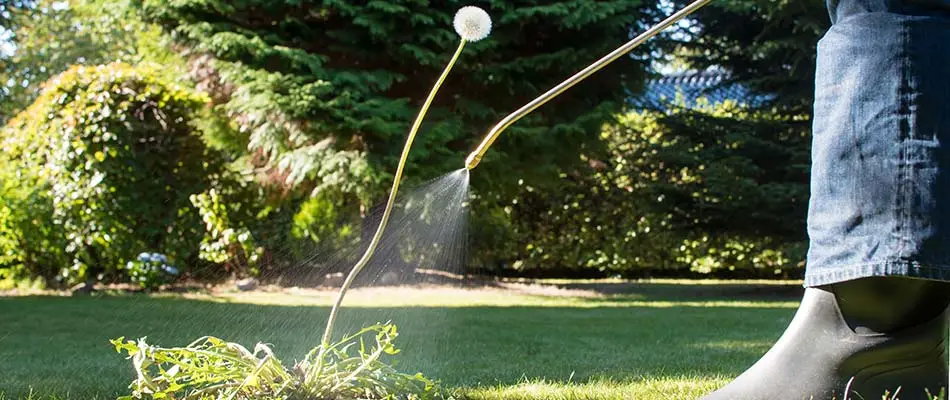The Good, the Bad, and the Ugly
Weeds in the lawn and garden are ugly. Maybe the kids are having a great time running around blowing dandelion seeds at each other, but you’d rather that were happening in a field somewhere instead of in the front lawn you’ve worked hard to maintain.
The bad news is that the weeds are there. Even though you went with a pre-emergent treatment to prevent the growth of certain weeds, you knew that you would still get some weeds because there are some weeds that pre-emergents cannot prevent (dandelions and clover, for example). And there they are.
The good news is that there are highly effective means to deal with the problem. Now, if you happen to enjoy spending hours of your precious free time yanking weeds out of the ground, then, by all means, have at it. But a much better solution is the use of post-emergent herbicides.
What Post-Emergent Herbicides Are and What They Do
Unlike pre-emergent herbicides, which stop weed growth before it can ever get started, post-emergents attack weeds after they appear. Like pre-emergents, they come in granular forms requiring a spreader and liquid forms requiring a spray bottle.
There are two categories of post-emergent herbicides: systemic applications and contact applications. Knowing what kinds of weeds you have helps determine which treatments to apply.
Systemic herbicides are effective against perennial weeds because the plant absorbs them, ensuring that the entire plant dies. These applications not only kill the target plant but also prevent it from coming back.
Contact herbicides work well against annual weeds by targeting exposed parts such as the stem and leaves. Killing those exposed parts is usually enough to destroy the plant.
Post-emergent herbicides can also be selective or non-selective, meaning they target either specific plants or broad groups of them. In a lawn or garden, you are more likely to use a selective herbicide because you want to kill the weeds without harming the surrounding grass and other plants. A good example of the use of non-selective herbicides is for weeds and grass control in concrete cracks, such as in sidewalks and driveways.
It’s important to be patient. Results may sometimes appear within hours, but in some cases, it can take several days or even weeks for weeds to disappear.
Considerations Before Using
Now, it might sound tempting and even fun to head out to the store, buy some herbicide, and start spraying away, but that isn’t such a great idea. Without careful consideration, you might make matters worse.
First, to repeat something we covered in the previous section, it’s important to know what weeds you have so that you know what types of herbicides you need. Related to that is the importance of reading the information that comes with the product in order to understand how, when, and where to apply it. It matters.
Only apply herbicides in dry weather and when it is expected to stay dry for at least a few hours. Liquid applications need time to dry, and you also don’t want any treatment washing away before it can take effect. Similarly, if it is necessary to water the product in, do so within the allotted time on the label.
Never spray on a windy day. If you do, the herbicide may come into contact with plants you do not want it to. More importantly, the herbicide could get on your skin or, worse, into the eyes, nose, or mouth. Using gloves and eye protection is always highly recommended regardless of conditions.
Read warning labels. Some products contain ingredients that some agencies here in the U.S. and internationally have banned or limited use of out of concerns that they can cause cancer. There has been no definitive proof that such products are carcinogenic, but the concerns remain. Be an informed consumer and make informed decisions.
Finally, think twice about using products that are a combination of fertilizer and herbicide. Although these products are abundant and popular, many experts warn that they are not as effective as advertised because of difficult application processes, and the best time windows for fertilizing and for applying herbicides usually do not overlap.
Let Us Help
All of this may seem like a lot to digest, and it can be. So why not consider professional services like those Sharp Lawn Care provides? Will this cost you more money? Well, yes, but maybe no. Yes, you will be paying for work you might be able to do on your own, but if you use the wrong herbicides, accidentally kill “good” plants, or become sick or injured due to misuse, it could end up costing you more in the long run. The experts at Sharp Lawn care will get it right the first time.
Besides, think of all the time you’ll have to do things you’d rather do. It’s hard to put a true value on that.
By letting us fight the weeds for you, you will benefit by saving time and by having the peace of mind that comes from knowing we are taking care of you, your family, and your property.
Contact Sharp Lawn Care for post-emergent weed control treatments for your property.
We’ve linked tools and products in this article that may help you complete this work yourself. As an Amazon Associate, we earn from qualifying purchases.




Comments (0)
Thanks for your comment!
Thanks for your feedback! Your comments have been successfully submitted! Please note, all comments require admin approval prior to display.
Error submitting comment!
There is a problem with your comment, please see below and try again.